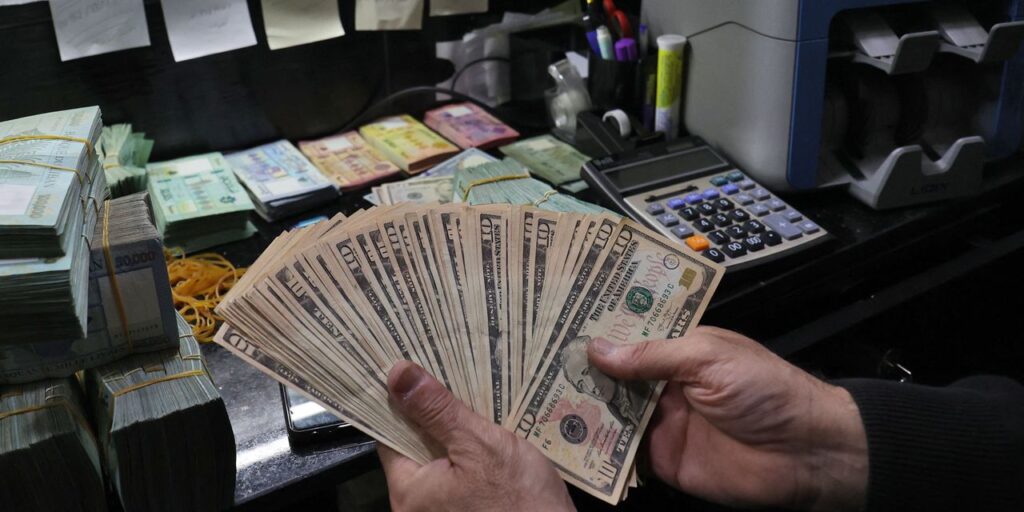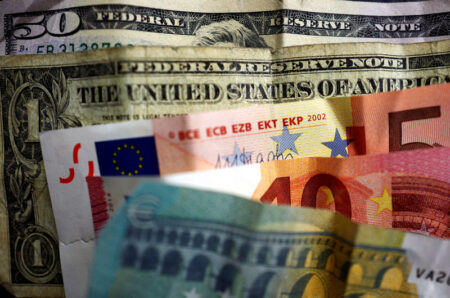The U.S. dollar’s resurgence in recent months can be boiled down to fears of financial instability, according to an analysis by the Wells Fargo Investment Institute.
The dollar rose dramatically in 2022 as stocks and other financial assets dropped as the Federal Reserve began raising rates at one of the quickest clips in decades, with a surging greenback wreaking havoc around the world.
While its dominance slightly waned in early 2023, the dollar shot higher again in March and May. A look at the ICE U.S. Dollar Index
DXY,
(red dots in below chart) shows its advance after the collapse of Silicon Valley Bank sparked fears of a broader regional banking crisis, while traders began pricing in almost a 1% drop in the Fed’s policy rate (blue line).
The DXY index edged 0.5% lower Tuesday to 103.18, but was on pace to gain 0.5% from a month ago, according to FactSet. The index measures the U.S. dollar against the euro, Japanese yen, British pound, Canadian dollar, Swedish krona and Swiss franc.
The dollar’s pullback from its September peak prompted some speculation about whether the dollar might eventually lose its crown as the world’s reserve currency, as MarketWatch’s Joseph Adinolfi wrote in April.
The dollar gained in March when the financial system looked vulnerable to stress from regional banks, including as the KBW Regional Banking Index
KRX,
declined. But it backed off again in May, until the U.S. debt-ceiling fight threatened to leave the U.S. short on paying its bills.
Treasury Secretary Janet Yellen initially warned Congress that might happen as soon as June 1, without a U.S. debt-ceiling deal, but later revised it to June 5.
Default averted
The dollar has stayed elevated in June after a debt-ceiling resolution was hashed out, avoiding a catastrophic U.S. default. Fed-fund futures also recently point to only a single, 25-basis-point rate cut this year.
That might suggest markets now more fully agree with the Fed’s guidance of no rate cuts in 2023. But Peter Wilson, global fixed-income strategist at the Wells Fargo Investment Institute, thinks the “mystery” behind why the fed-funds futures market was pricing in dramatic rate cuts earlier this year, despite consistent Fed messaging “to the contrary,” was likely related to hedging activity.
Specifically, he pointed in a client note Monday to a “need to hedge against the non-negligible risk that something breaks,” as a catalyst for the mismatch, since financial instability could force the Fed to respond with lower rates.
“Now that these risks have faded, it is reasonable that the futures market is pricing less than one 25 basis-point cut by year end, and the dollar has risen back into the top half of its 2023 trading range,” Wilson wrote.
However, his team also expects the Fed to raise rates at least once more this year, and to keep them at peak levels until 2024, which also should result in the dollar sticking to a higher trading range through December and “only showing a clearer depreciation trend in 2024.”
The Wells Fargo strategy team said a soft landing for the U.S. economy looks to be unsuccessful, and expects a recession to occur before inflation is under control.
Stocks advanced Tuesday ahead of the Fed’s rate decision on Wednesday. The Nasdaq Composite Index
COMP,
and S&P 500 index
SPX,
on Monday closed at their highest levels since April 2022, while the Dow Jones Industrial Average
DJIA,
climbed for a fifth session in a row.
The S&P 500 climbed out of a long bear market last week, which has been fueling a bullish shift among more equity investors, despite the continued threat of recession.
Fed officials this week are expected to skip a June rate hike, but are expected to consider additional rate increases beyond the current 5%-5.25% policy range.
Related: It’s a ‘bull market’ for stocks. Here’s what that means.
Read the full article here













